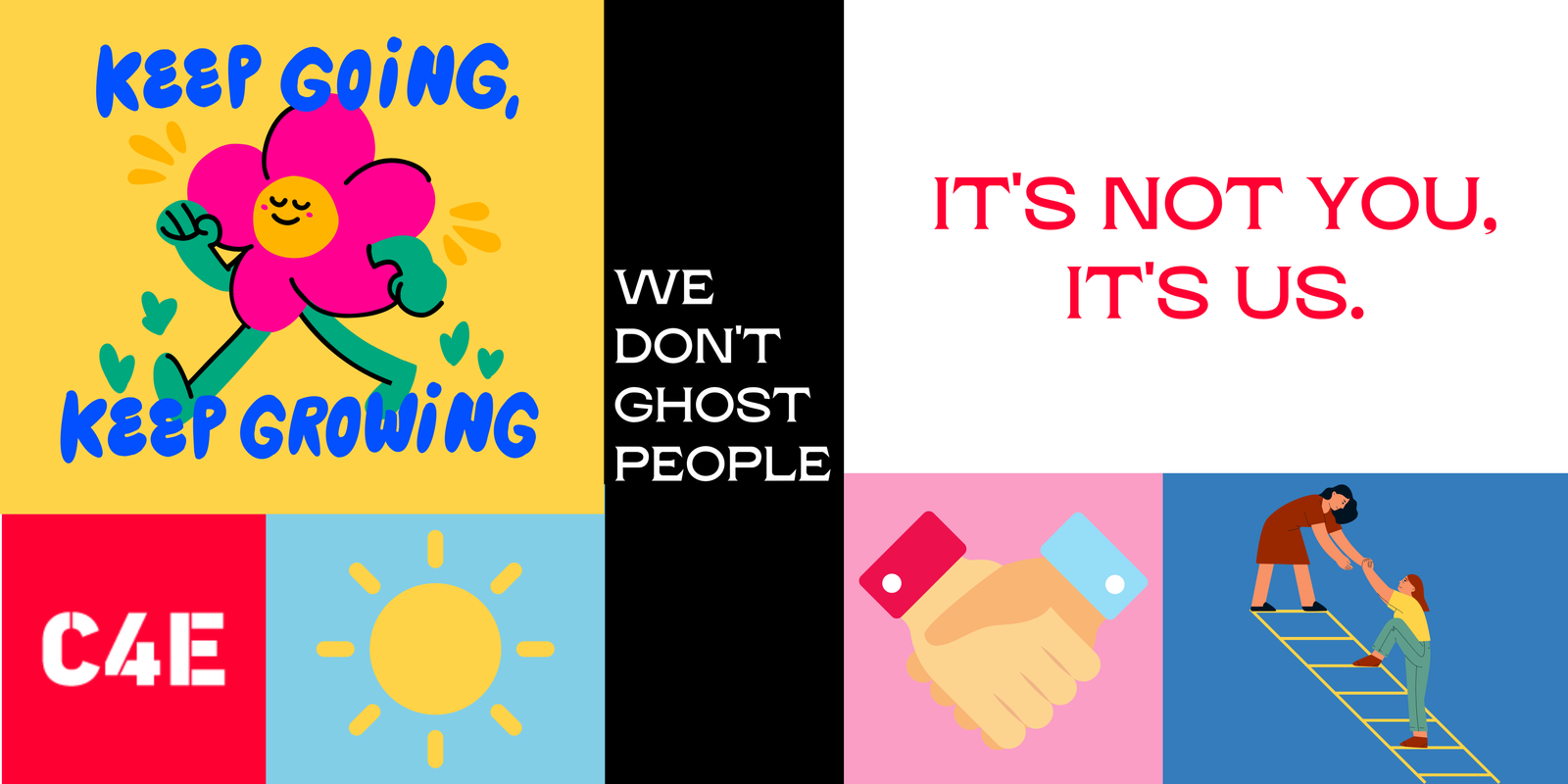
Here, you leave with closure.
The C4E “Rejection”
You’ve applied to multiple companies this month. It’s been both exciting and exhausting – chasing people for confirmations, working on multiple copy tests (all while thinking, I should not be working on unpaid samples), and figuring out the sweet spot of follow-ups. You may not enjoy the process, but you are hopeful of the destination – a great team, a great organisation.
At C4E, each of us has been there at some point and thus we get your anguish. We’re a team of creative dreamers and doers and have had our fair share of unfinished conversations, rejections, and ambiguity.
Today, while we’re on the other side of things – having people apply to work with us – we’re attempting to do better, starting with rejections.
So, what is the C4E Rejection?
Wait. We don’t even want to call it a rejection. This is no popularity contest. This is more of a check on the fitment and often two great people don’t click.
So, to us, the ‘right’ rejection does the following things:
1/ Lets the person know that we won’t be going ahead with the engagement. In other words, no ghosting.
2/ Provides closure. Yep, I’m talking about the same closure we demand in our relationships. After all, even work is a relationship between two people.
While openness in conversations may be really difficult, we humans are programmed to do better with clarity than with ambiguity and uncertainty. Think of each time you’ve wanted to ask why you didn’t get through at a company. Or you hoped to have a conversation about how you could do better.
That is what we aim to give our people, before they have to ask.
How do we do it?
By treating each person we talk to as they ought to be treated – as humans. And then through a few basic things. Starting with open conversations. Our ‘rejection’ has three things: an apology, a reason and an offer.
A. The Apology
This is for not being able to go ahead with the engagement. We think it’s the bare minimum thing to do.
Again, this is not a reflection on the person or the work. This is mere documentation that we are two different people and we may not click.
B. The Reason
The most important part is the reason. We try our best to explain why we think the engagement/relationship won’t work. And, in my experience of hiring for C4E for over a year now, the ONLY reason we’ve been able to have this open conversation is because we know exactly what we want.
To provide some context, here’s our culture handbook. When we laid this down, the idea was ONLY to attract those people who subscribe to each thing we’ve said here. Those who jump off their chairs and say, “I’ve been looking for this my entire life.” And those who have an itch they want to scratch.
Often, when we have to say no to someone, it’s not because of their abilities or skills. It’s simply because they don’t look at the world the way we do. They don’t look at work the way we do.
And so we say, “it’s not you. It’s us.”
As I write this, I realise the reputation of this sentence. It’s used as an excuse. As an escape. It’s even a cheesy dialogue used in my favourite rom-coms. But, at C4E, we mean it.
P.S. We would like to do more here. A few months ago, we came across Surge’s rejection email. And, here’s a video they send to the startups that don’t get chosen – Surge Decoded: Why Was My Startup Not Chosen for Surge?
We like it because it’s elaborate, leaves no room for doubt or ambiguity, and tells the founders everything they need to know for next time.
If I may, it’s the crème de la crème of rejections. And I think ours come close.
C. The Offer
Before a goodbye, we ask the person if they’d like feedback on their work or communication. This is specific to cases where they would’ve worked on a sample project for us (which in most cases are paid!). Or, engaged with the team multiple times before we made our decision.
The reason we ask before giving feedback is that (surprisingly), not everyone wants it. At least not immediately.
That’s about it – the C4E way of doing things.
Before I go, I want to leave you with an offer you may not want to refuse.
An offer to join us – as a partner, a client, or as a fan :D. While we don’t have a specific open role, do talk to any of us. You’d be surprised by how laissez-faire we are about roles. And because we’re always looking to work with people who align with the way we do things.
As a client, we are as selective about the people who we choose to work with as we are picky with clients. Do read the C4E promise and see if what we say makes sense.
And if nothing else, our remote team is at places like Mumbai, Bangalore, Nasik, Pune, and Toronto. Text us and let’s grab a coffee. Preferably at a Starbucks.
Oh, and we are hyperactive on Twitter. Just saying!
Signing off,
Chandni (@chandniDD),
Culture Custodian, C4E
<3

